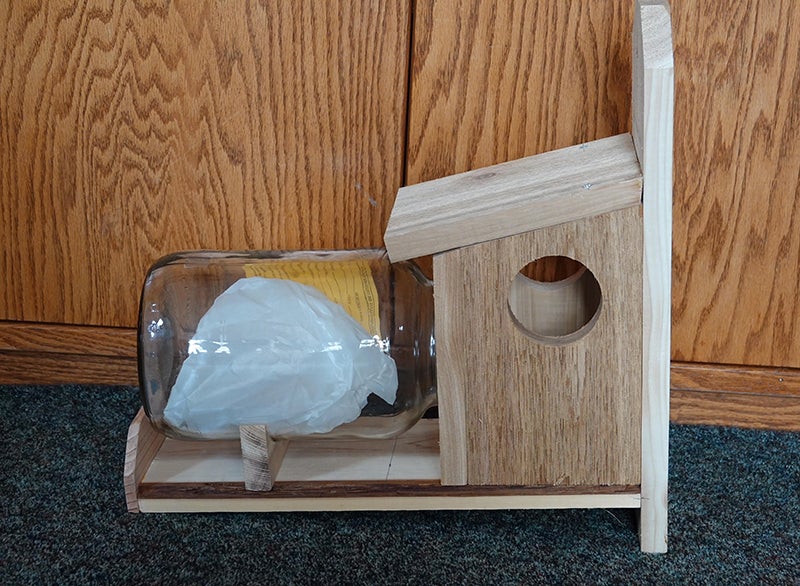Al Batt: Consider personal birding preferences when choosing binoculars
Published 11:11 am Saturday, December 23, 2017

- This squirrel feeder was built by Jerry Determan of Fairmont. The squirrel and the corn go where the white bag is inside the jar. - Al Batt/Albert Lea Tribune
Al Batt of Hartland is a member of the Albert Lea Audubon Society. Email him at SnoEowl@aol.com.
My neighbor Crandall stops by.
“How are you doing?” I ask.
“Everything is nearly copacetic. I wish I didn’t have anything to do and more time to do it. We’re having a terrible spell of weahthur, but I’m tolerable hardy today. Now that the farm has gone on winter hours, I’ve been walking at the mall. It’s part walk, part run. I walk until I have to run to the emergency room. I’m being nice to everyone I encounter because it’s all fun and games until Santa checks his naughty list.”
Naturally
I stepped outside to look at the moon. It was dark and if the moon had been a musical instrument, it would have been blaring. The darkness caused me to think of the poet Tom Hennen’s book titled “Darkness Sticks to Everything.”
Weather keeps a mind sharp. A man has to think about what to wear. The north wind blew in birds or the birds dragged the north wind with them. The wind has to blow. It’s the only job it has. I drove most of the day, going here and there. I watched a bald eagle and a crow feeding on a roadkilled deer. The eagle fed on one side, the crow on the other as they enjoyed the holiday feast of venison. I was traveling a windswept highway near dusk when I spotted a murder of crows readying to roost in evergreens used as a living snow fence. I’ve become more accustomed to seeing winter roosts of crows in cities. Crows flock because there is safety in numbers, but they could do that anywhere there are trees. A city serves them well for a number of reasons. No hunting, fewer great horned owls, artificial light that helps spot owls, large trees for roosting and cities are warmer than rural areas.
It’s a wonderful world, isn’t it?
Q&A
“Are there birds that eat monarch butterflies at their wintering site in Mexico?” Eating monarchs makes most birds barf, but black-headed grosbeaks and black-backed orioles prey on the butterflies.
“Which raptor is the ‘chicken hawk’?” It could be any hawk large enough to kill a chicken, but I think the Cooper’s hawk is the most likely to carry that nickname.
“Are quail native to Minnesota?” Northern bobwhite, often called bobwhite quail, moved north into the state with the farming practices of more than 150 years ago. Quail expanded their range when the settlers broke up the soil to create landscapes favoring the birds. This was particularly true in the southeastern portion of the state.
“Can deer have rabies?” It’s incredibly rare for a deer to have the disease, but all mammals can get rabies. The most common wild reservoirs of rabies are raccoons, skunks, bats, foxes and coyotes. Domestic mammals also get rabies. Cats, cattle and dogs are the most frequently reported rabid domestic animals in the U.S.
“What binoculars are good for birding?” I like 7x, 8x or 10x magnification. Some birders prefer higher magnification to discern detail and see birds at a long distance. Others prefer the brighter image and wider field of view offered by 7x or 8x binoculars. Hand-shake can be an issue with 10x binoculars. The overall feel of binoculars is important. They need to fit your hands and eyes.
Leonid Skorin of Albert Lea asked if the presence of Canada geese in a lake could keep water from freezing. Many geese moving about in water could likely keep it open. Whether it’s deliberate or not, their presence and movement might keep ice from forming in a small area until temperatures drop too low. Geese are smart. I like geese. As a turkey said at Thanksgiving, “Give geese a chance.”
“What’s a good gift for nature lovers?” Warm gloves or socks, books, a state park sticker, a bird feeder, a membership in a local nature organization or a nature experience are but a few.
“Are ospreys used in falconry?” An osprey’s diet is almost exclusively live fish. They are excellent anglers, but not traditionally used in falconry. Although it doesn’t lend itself to falconry, the possibility of using an osprey to catch fish is intriguing.
“Which county has the most Lakes?” Otter Tail County with 1,048 lakes. Four counties in Minnesota have no natural lakes: Mower, Olmsted, Pipestone and Rock. Legend has it that Minnesota’s 10,000 lakes formed in the footprints of Paul Bunyan’s blue ox Babe. There are 15,291 lakes of at least 10 acres.
Thanks
for stopping by
“Christmas gift suggestions: To your enemy, forgiveness. To an opponent, tolerance. To a friend, your heart. To a customer, service. To all, charity. To every child, a good example. To yourself, respect.” — Oren Arnold
“What is Christmas? It is tenderness for the past, courage for the present, hope for the future. It is a fervent wish that every cup may overflow with blessings rich and eternal, and that every path may lead to peace.” — Agnes M. Pahro
Do good.


